Click on images to enlarge

infestation (Photo: Forest and Kim Starr, USGS)
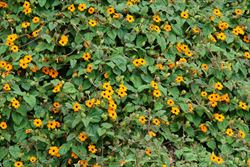
habit (Photo: Forest and Kim Starr, USGS)

climbing habit (Photo: Sheldon Navie)
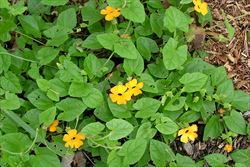
creeping habit (Photo: Sheldon Navie)

leaves (Photo: Sheldon Navie)
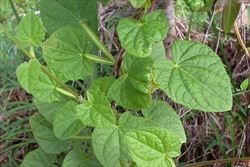
leaves with slightly winged petioles (Photo: Sheldon Navie)
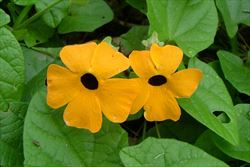
orange flowers with black centres (Photo: Sheldon Navie)
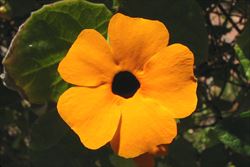
close-up of flower (Photo: Sheldon Navie)
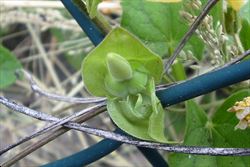
close-up of immature fruit with two large leafy floral bracts and small narrow sepals (Photo: Sheldon Navie)

immature fruit and old fruit stalks with persistent sepals (Photo: Sheldon Navie)
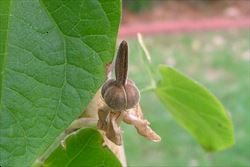
mature fruit (Photo: Sheldon Navie)
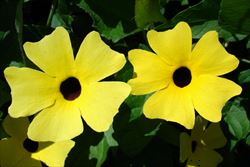
Thunbergia alata cultivar with bright yellow flowers (Photo: Forest and Kim Starr, USGS)
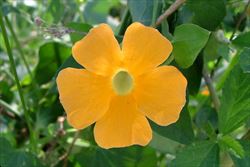
Thunbergia alata cultivar with entirely orange flowers (Photo: Sheldon Navie)
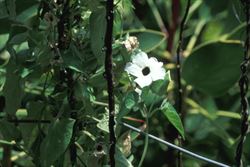
Thunbergia alata 'Alba', a cultivar with white flowers (Photo: Forest and Kim Starr, USGS)
Scientific Name
Thunbergia alata Bojer ex Sims
Family
Acanthaceae
Common Names
black eyed Susan, black eyed Susan vine, black-eye Susan vine, black-eyed Susan, blackeyed Susan, black-eyed Susan vine, blackeyed Susan vine, clock vine, clockvine
Origin
Native to tropical and southern Africa (i.e. the Ivory Coast, Liberia, Nigeria, Sierra Leone, Eritrea, Ethiopia, Sudan, Kenya, Tanzania, Uganda, Rwanda, Malawi, Mozambique, Botswana, South Africa and Swaziland).
Cultivation
An introduced garden plant (i.e. ornamental) that is sometimes cultivated for its attractive flowers. It is most often grown on trellises and fences, particularly in warmer regions. Several cultivars have been developed, including some with white, yellow and even pinkish-coloured flowers.
Naturalised Distribution
It has become widely naturalised in the coastal districts of eastern Australia (i.e. in the coastal districts of eastern Queensland and eastern New South Wales). Also naturalised in south-western Western Australia.
Naturalised overseas in southern USA (i.e. Texas and Florida), Papua New Guinea and on several Pacific islands (i.e. Fiji, Guam, Western Samoa and Hawaii).
Habitat
A weed of waterways (i.e. riparian vegetation), urban bushland, forest margins, plantation crops, roadsides, disturbed sites and waste areas in tropical, sub-tropical and warmer temperate regions.
Habit
A long-lived (i.e. perennial) herbaceous climber growing up to 5 m in height.
Distinguishing Features
- a long-lived vine growing up to 5 m in height.
- its slender stems are green and hairy when young.
- its paired leaves (2-8 cm long and 1-4.5 cm wide) are borne on narrowly winged stalks.
- its tubular flowers (3-4 cm wide) are borne singly in the upper leaf forks on stalks 30-95 mm long.
- these flowers are usually orange or yellow with a black throat and have two leafy bracts at their bases.
- its fruit has a rounded base (5-10 mm across) containing the seeds and an elongated beak (9-15 mm long).
Stems and Leaves
Its slender stems are green and hairy (i.e. pubescent) when young.
The oppositely arranged leaves are borne on narrowly winged stalks (i.e. petioles) 1.5-6 cm long. These leaves (2-8 cm long and 1-4.5 cm wide) are egg-shaped in outline (i.e. ovate) or arrow-shaped (i.e. hastate or saggitate) with entire to toothed (i.e. dentate) margins and pointed tips (i.e. acuminate, acute or mucronate apices). Their upper surfaces are mostly hairless (i.e. glabrous) or slightly hairy (i.e. puberulous), while their undersides are hairy along their veins.
Flowers and Fruit
The flowers are borne singly in the upper leaf forks on stalks (i.e. pedicels) 30-95 mm long. These tubular flowers (3-4 cm wide) are predominantly orange or yellow with a black throat. There are two leafy bracts (12-20 mm long) at the base of each flower, which can be easily mistaken for sepals. They also have 11-14 tiny sepals that are joined together into a calyx 2-3 mm long. Their petals are fused into a tube (i.e. corolla tube) 15-25 mm long with five spreading petal lobes (10-15 mm long). Each flower also has four stamens and an ovary topped with a style and stigma. Flowering occurs throughout the year, but is most abundant during spring and summer.
The fruit capsule has a rounded (i.e. globular) base (5-10 mm across) containing the seeds and an elongated beak (9-15 mm long). This capsule is finely hairy (i.e. tomentose) and turns from green to brown as it matures. The seeds (about 4 mm across) are warty and ribbed.
Reproduction and Dispersal
This species reproduces by seed, and vegetatively by fragments of stems and roots.
Seeds and plant fragments can be spread in dumped garden waste. They can also be spread by water and vehicles.
Environmental Impact
Black-eyed Susan (Thunbergia alata) is regarded as an environmental weed in New South Wales and Queensland. It is also a potential environmental weed or "sleeper weed" in Western Australia and the Northern Territory.
Legislation
Not declared or considered noxious by any state government authorities.

